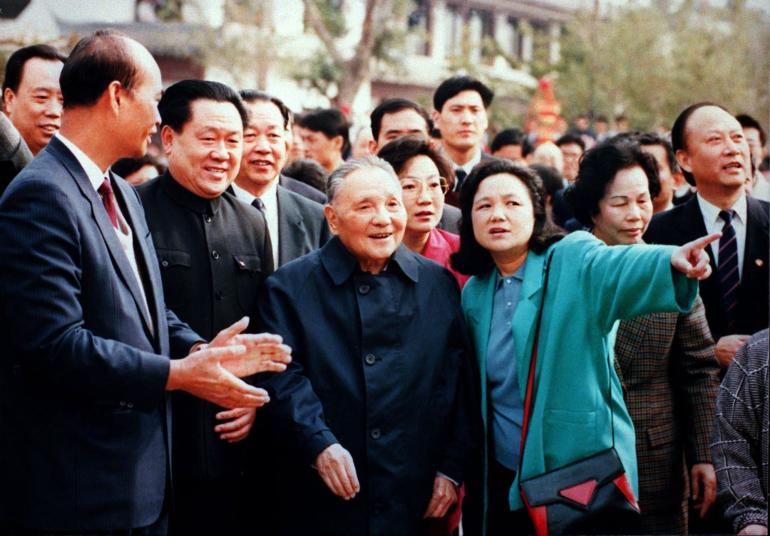Keyu Jin is a professor of economics at the London School of Economics. Her analysis represents her views alone.
![]()
This year marks the 40th anniversary of China’s economic reform and opening-up program. China has transformed itself from a once economic backwater to a manufacturing powerhouse, on its way to becoming the world’s largest and most connected component. If every era is marked by a series of common themes, the current one in which we are living is undoubtedly one about China’s emergence, and its quest to achieve its destiny on its own terms.
Before looking forward, one can now look backward for new insights, with the aid of more evidence and perspective. Perhaps one of the most misunderstood aspects of China’s rise was the drivers of its rapid growth in the first three decades. The common perception is that China grew based on capital accumulation, and investment, the bridges that led to nowhere, and the empty buildings that gave rise to ‘ghost cities.’ Well, the data and evidence reject this view decidedly.
First, a few pieces of evidence would already point out the fallacies of this theory. Why would the annual rate of return to capital remain so high for so long? According to a variety of academic studies, it was about 25% over the period of 1978-2007 (see Bai et al. (2006) updated, Lu et al. (2008) and Dong et. Al (2006). This is much higher than the average rate of return for countries, and the surprising element of this is that it lasted for so long.
If any economy’s growth impetus was reaching levels of satiation because of over-investment, then the returns to capital should precipitously decline to a low level. But clearly, this did not happen. Even in the recent decade, during which the economy has started to slow down, the rate of return has been above 10%.
Another piece of evidence that doesn’t jibe with the ‘over-investment’ conjecture is that the capital to output ratio has been relatively constant over this period, rather than rapidly rising. This means that capital did not lead, but grew at the same pace, with output.
So, what explains China’s growth? An under-appreciated, but instrumental, factor is the reduction in the distortions embedded in the economy. During the first thirty years of reforms, distortions were mitigated, so that resources could be better allocated across sectors and firms. Indeed, resources moved from low-productivity to high-productivity areas—in particular, from agriculture to manufacturing, and from state-owned firms to private firms. This process significantly raised an economy’s efficiency.
The private (non-state) sector grew from a negligible share of output in 1980 to more than 80% of output in 2007. Four hundred million people moved from agriculture to industry in the period between 1978 and the 1990’s. These two large structural transformations underpinned China’s growth in these two decades.
Total factor productivity growth achieved a stellar 3.61% average annual growth rate (1978-2007), which is higher than what most other countries had experienced, and certainly higher than the 0.5% growth coming out of advanced economies in the same timeframe. The bottom line is that it is not always about accumulating more resources (labor or capital) that propels growth. By simply using existing resources more efficiently, a country’s productivity level can dramatically improve.
The thirty or so years prior to 1978 saw an entirely different story unfold. The period of 1950-1978 featured a full reliance on capital accumulation to achieve the slight growth that it had. It witnessed the lamentable episodes of the Cultural Revolution and the Great Leap forward, the instructions to materialize the wildly optimistic dream of Mao to surpass the U.S. and the USSR in steel production. Kitchen pots were melted, and metal was scrapped in backyards to concoct ‘capital.’ Total Factor Productivity (TFP), not surprisingly, experienced a large decline in between 1950-1978.
The last decade, however, saw a reversal of reform initiatives; it also experienced a very slow productivity growth, partly because the large fiscal stimulus after 2009 increased the misallocation of capital, as resources went to big firms and low-productivity projects.
Looking forward, the next forty years will be another important stage for the Chinese economy. China has certainly ‘emerged,’ but is far from becoming a rich country. Whether it will escape the ‘middle income trap,’ and whether it will continue to raise the living standards of all its citizens remains an open question. To continue growing, China’s needs to rely on productivity growth, and on innovation, which is the only sustainable factor for long-term growth.
Recent trade tensions seem to push China towards more self-sufficiency—whether it is to rely less on external economies and more on indigenous technologies, or to strengthen IP protection, which is inherently good. A new phase of growth potential has begun. We shall look back in forty years, hopefully with the same sense of accomplishment and pride as we have today.
 CGTN America
CGTN America Photo: VCG
Photo: VCG

